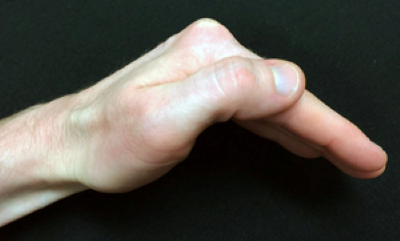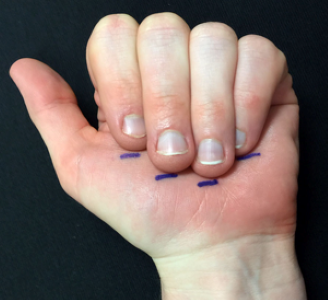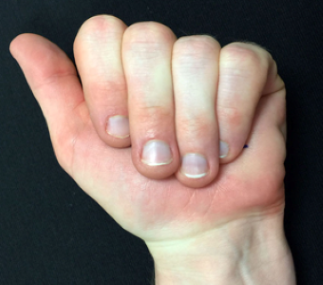Active Exercise for Finger MP Joint Flexion

June 2015 No. 35
Active Exercise for Finger MP Joint Flexion
Judy Colditz, OT/L, CHT, FAOTA
Following injury and/or immobilization of the hand, a loss of both active and passive metacarpophalangeal (MP) joint flexion of the fingers is often noted.
To address this loss, therapists frequently instruct patients on active exercises for simultaneous MP joint flexion and interphalangeal (IP) joint extension. Some refer to this exercise as “making a rooftop” or the intrinsic-plus position (Figure 1). (Others mistakenly call it the lumbrical-plus position.)


Figure 1
Another approach may be more helpful. Below is the rationale and the exercise description:
In the normal hand, the MP and IP joints extend at the same time and also flex at the same time. When attempting to flex the MP joints and extend the IP joints simultaneously, it is increasingly difficult to maintain full IP extension at or near end-range of MP joint flexion. The converse is also true: full MP joint flexion is not possible if full IP joint extension is maintained. Try it on your own hand.
The “rooftop” exercise demands the interosseous muscles (and to some extent the lumbrical muscles) move adjacent joints in opposite directions, creating a competition between movement at the MP and IP joints:
•The interosseous muscles (both dorsal and volar) insert into both sides of the dorsal apparatus and transmit tension via the proximal transverse fibers to flex the MP joints. These muscles are the only primary MP joint flexors.
•The interosseous muscles also transmit tension to the oblique fibers to extend the IP joints, but the oblique fibers receive the most direct pull from the interosseous muscles when the MP joint is in extension.
•Therefore, when one attempts simultaneous MP joint flexion and IP joint extension, the interosseous muscles have difficulty giving the same power to both the MP and the IP joints.
•Many think the lumbrical muscle primarily flexes the MP joint but Long demonstrated that the lumbrical muscle primarily extends the IP joints and is a weak MP joint flexor.(1)
The strongest interosseous muscle contraction for MP joint flexion occurs during end-range gripping. Try it: 1) Gently close your fingers around an imaginary small glass tube and 2) squeeze/grip very tightly to crush the imaginary glass tube. You will feel your MP joints being pulled into the end range of finger flexion by your interosseous muscles. But your flexed DIP joints will be in the way, preventing full MP joint flexion.
In addition to the interosseous muscles being active for powerful MP joint flexion at end range, the FDS is also most active during power grip.
Considering the factors outlined above, the better exercise choice may be active MP joint flexion that simultaneously activates both the interosseous muscles for MP joint flexion and the FDS for PIP joint flexion:
1. Instruct the patient to place their fingertips flat on their palm (using only the FDS) and place a mark on the palm at the end of each fingertip (Figure 2).


Figure 2
2. Instruct the patient to move the fingertips to “cover the marks” (move the fingertips proximally) (Figure 3). Note: The marks are useful at the time of initial instruction and for patient feedback, but are not necessary to do the exercise.


Figure 3
This exercise isolates end-range MP joint flexion synchronically with FDS activation, reflecting the normal synergistic muscle contraction during power grip.
TIP: A quick way to determine MP joint flexion progress is to place a mark at the end of the fingertips when the patient is at the maximum MP joint flexion position. These may be your second set of marks if you placed other marks at the beginning of the exercise. Measure the distance of each mark from the distal palmar crease and compare to the same measurements at the last/next visit (Figure 4).


Figure 4
References
Long C, Conrad M, Hall E, Furler M. Intrinsic-extrinsic muscle control of the hand in power grip and precision handling. JBJS 1970;52-A(5):853-867.
Download Clinical Pearl No. 35, Active Exercise for Finger MP Joint Flexion, June 2015
© HandLab; 2015 all rights reserved
Disclaimer: HandLab Clinical Pearls are intended to be an informal sharing of practical clinical ideas; not formal evidence-based conclusions of fact.
